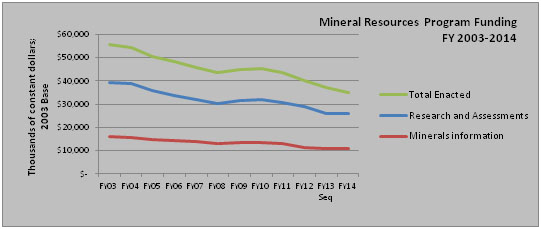The Minerals Science and Information Coalition is a broad-based alliance alarmed by, and concerned about the ramifications from, the lack of commitment to and investment in the minerals science and information functions of the U.S. federal government.
Recognizing that a stable supply of minerals is essential for the economy and national defense, the Minerals Science and Information Coalition respectfully asks Congress to provide additional funding for mineral research and information functions in the federal government. We ask that new funds be authorized and appropriated to develop forecasting capabilities in the National Minerals Information Center at the U.S. Geological Survey (USGS). Forecasting capabilities are critical to understanding supply chain dynamics and ensuring a stable supply of mineral commodities for national infrastructure, manufacturing, and technology. These additional funds should not come at the expense of existing minerals or geological functions at USGS.
Coalition Members
American Chemical Society
American Exploration & Mining Association
American Geosciences Institute
American Physical Society
Associated Equipment Distributors
Geological Society of America
Industrial Minerals Association – North America
Materials Research Society
Mining and Metallurgical Society of America
National Electrical Manufacturers Association
National Mining Association
National Stone, Sand and Gravel Association
Portland Cement Association
Society of Economic Geologists
Society for Mining, Metallurgy and Exploration
Background on Federal Minerals Science & Information Funding
To safeguard its supply chains and maintain a competitive position in the global economy, U.S. industry must have accurate, timely information on the location and nature of mineral resources, and on the supply of, demand for, and flow of all minerals and materials. A 2013 report by the National Research Council, found, “Energy and mineral resources are essential for the nation’s fundamental functions, its economy, and its security.” Nevertheless,
-
Federal programs in minerals science, research, information, data collection and analysis have been severely weakened. Funding for the U.S. Geological Survey’s Mineral Resources Program, the only primary source for minerals science and information, has been cut by 30% in constant dollar terms over the last decade, reducing its ability to provide this critical information.
-
The U.S. government has insufficient capacity to forecast future trends in the supply of and demand for minerals and thus is unable to anticipate and mitigate disruptions in supply chains or supplies necessary for our energy security and national defense.
Why Federal Minerals Programs are Important to the Nation
- Private sector companies as well as the departments of Interior, Defense, and State, the CIA, and the Federal Reserve depend on the information collected by the Minerals Information Program.
- The Federal Reserve Board uses these data to calculate the indexes of industrial production, capacity, and capacity utilization, which are among the most widely followed monthly indicators of the U.S. economy.
- Virtually every manufacturing sector, from aviation to textiles, relies on the unbiased data reported by the Minerals Information Program. The information for a number of the MIP reports is derived from proprietary information shared by commercial entities precisely because the government is a trusted third party.
- American manufacturers currently rely on foreign suppliers for more than half of the minerals they use in finished products. With this level of import reliance, manufacturers rely on impartial information from USGS about the global flow of minerals to build secure supply chains.
- The DOD relies on MIP to develop and maintain the capability to provide strategic and critical material supply and demand estimates to help manage the National Defense Stockpile.
- USGS, DOE, and NSF carry out and fund fundamental, innovative minerals research.
Minerals in the Economy
- The estimated value of mineral production in the United States in 2013 was $74.3 billion, according to the U.S. Geological Survey.
- Twelve states each produced more than $2 billion worth of nonfuel mineral commodities in 2013.
- The clean energy economy would not be possible without mineral commodities including lithium for rechargeable batteries, copper for wiring in electric vehicles, neodymium for magnets in wind turbines, and tellurium for thin-film photovoltaic panels.
- The nation’s infrastructure – its roads, buildings, dams, and bridges – is built from mined aggregates.
- Industrial minerals play a fundamental role in the U.S. economy by providing affordable materials to a variety of industries including construction, agriculture and manufacturing. Their contribution to GDP is an estimated $33.5 billion.
- Approximately 750,000 tons of minerals are needed annually to maintain our national defense.


